Global Blockchain in Manufacturing Market Forecast
- Global market for blockchain in manufacturing to jump to witness a leapfrog from US$0.8 Bn in 2022 to US$35.5 Bn in 2030
- Market revenue likely to see expansion at a CAGR of 70.6% between 2023 and 2030
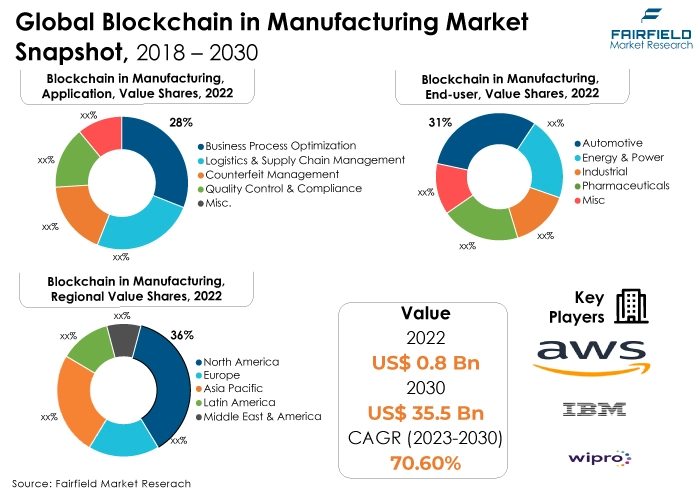
Quick Report Digest
- The key trend anticipated to fuel the growth of blockchain in manufacturing is the increasing demand from the automotive industry.
- The blockchain in manufacturing market is growing due to its ability to enhance supply chain transparency, improve product quality, and streamline processes. Manufacturers are increasingly adopting blockchain to meet regulatory requirements, reduce fraud, and ensure authenticity, driving the market's expansion.
- The growth in the manufacturing sector is fuelling the blockchain in manufacturing market as manufacturers seek to optimise operations, improve supply chain efficiency, and ensure product quality. Blockchain's transparency and traceability features align with these goals, making it a preferred technology for the industry's ongoing digital transformation.
- Business process optimisation application holds the largest market share in blockchain in manufacturing due to its ability to streamline manufacturing operations, enhance supply chain efficiency, and reduce costs, making it a preferred choice for manufacturers looking to improve their processes and competitiveness.
- The automotive end-user segment secured the largest market share in blockchain in manufacturing due to its complex and interconnected supply chains, which benefit significantly from blockchain's transparency, traceability, and quality control features, driving its adoption and dominance in the sector.
- North America has secured the largest market share in blockchain in manufacturing due to its mature manufacturing sector, regulatory support, and strong tech ecosystem. It has a well-established adoption of blockchain technology, driving its dominance in the market.
- Asia Pacific is expected to in blockchain in manufacturing due to its rapidly expanding manufacturing sector, government initiatives supporting Industry 4.0, and a growing focus on supply chain optimisation and regulatory compliance, driving blockchain adoption and growth in the region.
- Regulatory compliance is challenging the blockchain in the manufacturing market because it involves navigating complex and evolving regulatory frameworks across different regions and industries. Adhering to varying data protection, privacy, and quality standards while ensuring blockchain's benefits poses significant challenges for manufacturers and blockchain technology providers.
A Look Back and a Look Forward - Comparative Analysis
The blockchain in manufacturing market is growing due to its transformative potential in enhancing transparency, traceability, and efficiency across manufacturing processes. Blockchain technology offers secure and immutable records, reducing fraud and errors while ensuring the authenticity of products.
Manufacturers are increasingly adopting blockchain for supply chain management, quality assurance, and warranty tracking, driving market growth as the industry seeks to streamline operations, reduce costs, and meet stringent regulatory requirements.
The market witnessed staggered growth during the historical period 2018 – 2022. This is due to the substantial growth of the major end-use application sectors such as automotive and industrial. The automotive end-user segment in the blockchain manufacturing market is growing due to increasing demand for advanced vehicles with IoT connectivity, electric powertrains, and autonomous features. This necessitates innovative manufacturing processes, materials, and technologies, driving growth as automakers invest in modernisation to meet evolving market expectations and regulatory standards.
The future of the blockchain in the manufacturing market is poised for significant advancements driven by Industry 4.0 technologies. Automation, IoT, AI, and blockchain will continue to reshape manufacturing processes, increasing efficiency, reducing costs, and enabling agile production.
Sustainable practices, digital twins, and decentralised manufacturing will gain prominence. Additionally, supply chain resilience and customisation will be key focus areas, ensuring the industry's growth and adaptability in a rapidly changing landscape.
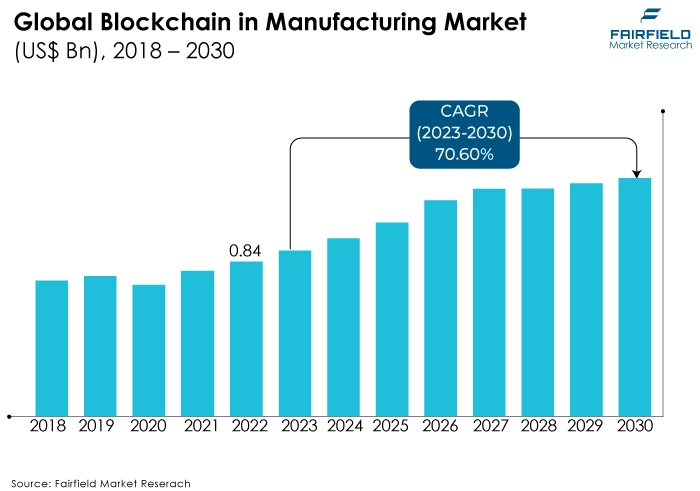
Key Growth Determinants
- Growth of Manufacturing Sector
Manufacturing industries worldwide are adopting advanced technologies like automation, IoT, and AI to enhance production efficiency, reduce costs, and improve product quality. This digital transformation is spurring demand for manufacturing software, robotics, and industrial IoT solutions. Additionally, the need for supply chain optimisation, customisation, and sustainability in manufacturing processes is further fuelling the market's growth as companies seek innovative solutions to remain competitive in the evolving landscape.
- Shortage of Skilled Labour
The shortage of skilled labour is driving the blockchain in manufacturing market by pushing manufacturers to adopt automation and digital technologies to compensate for the lack of human resources. This trend is boosting demand for robotics, artificial intelligence, and industrial IoT solutions, which can perform tasks efficiently with minimal human intervention.
Moreover, as manufacturers seek to reduce their dependence on skilled labour, these technologies are becoming essential for maintaining production levels and competitiveness, thus driving the growth of the blockchain in the manufacturing market.
- Transforming International Trade, and Supply Chain Management
The transformation of international trade and supply chain management is a significant driver of the blockchain in the manufacturing market. Globalisation and the need for efficient, resilient supply chains are compelling manufacturers to adopt advanced technologies like blockchain, and IoT for real-time tracking, traceability, and transparency. These innovations enhance supply chain reliability, reduce delays, and mitigate risks.
As international trade becomes more complex and regulations stricter, the adoption of these technologies is essential, driving growth in the blockchain in manufacturing market as manufacturers seek to optimise their supply chain operations.
Major Growth Barriers
- Potential Concerns Regarding Security, Privacy, and Control
Concerns about security, privacy, and control are significant challenges in the blockchain manufacturing market. As manufacturers adopt IoT, cloud computing, and Industry 4.0 technologies, they face increased vulnerabilities to cyberattacks and data breaches.
Ensuring robust cybersecurity measures and protecting sensitive information is paramount. Additionally, issues related to data ownership and control can arise when using third-party services and platforms.
Striking the right balance between connectivity and security is challenging but critical to maintaining trust and driving growth in the blockchain in the manufacturing industry.
- Uncertain Regulatory Compliance
The uncertain regulatory landscape poses challenges to the blockchain in the manufacturing market by creating ambiguity and compliance complexities. Rapid changes in regulations across industries, especially regarding safety, environmental standards, and data privacy, can lead to increased compliance costs and operational disruptions.
Manufacturers must navigate this evolving landscape, requiring investments in compliance management solutions and agility to adapt to new rules. The uncertainty and potential for regulatory hurdles can slow down decision-making and deter investments, impacting the overall growth and competitiveness of the Blockchain in the manufacturing market.
Key Trends and Opportunities to Look at
- Supply Chain Transparency
Supply chain transparency in blockchain in manufacturing uses blockchain technology to provide end-to-end visibility into supply chain operations. It enables manufacturers to track and verify the origin and movement of raw materials, components, and products in real time.
This transparency enhances accountability, reduces the risk of fraud or errors, and ensures authenticity throughout the supply chain, promoting trust among stakeholders and enabling more efficient and reliable manufacturing processes.
- IoT Integration
IoT Integration in blockchain in manufacturing combines the Internet of Things (IoT) with blockchain technology to create a secure and transparent ecosystem. IoT devices collect real-time data from manufacturing equipment and processes, which are then securely recorded on the blockchain. This integration enhances supply chain visibility, quality control, and traceability, enabling manufacturers to optimise operations, ensure product quality, and reduce the risk of counterfeit goods.
- Decentralised Manufacturing
Decentralised manufacturing in blockchain involves the use of distributed ledger technology to enable peer-to-peer manufacturing processes. It allows multiple parties to collaborate directly, reducing the need for intermediaries and centralised control. Smart contracts govern the production, quality assurance, and payments, increasing efficiency and transparency. This approach fosters trust and innovation within manufacturing networks while reducing costs and administrative overhead.
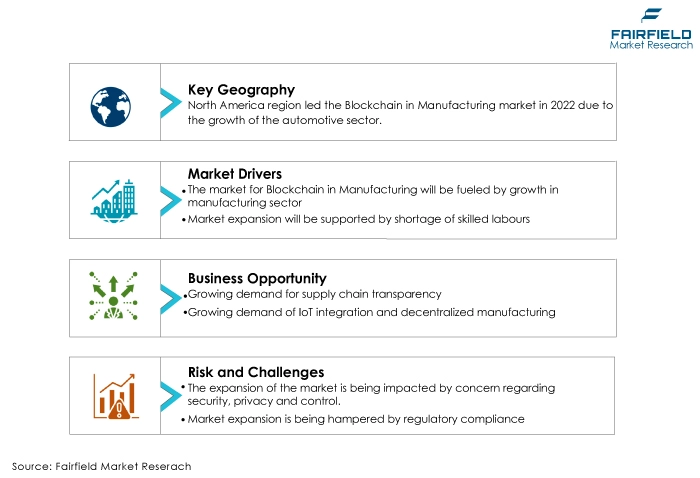
How Does the Regulatory Scenario Shape this Industry?
The regulatory scenario plays a significant role in shaping the adoption and implementation of blockchain in manufacturing. Manufacturers must navigate a complex web of regulations that vary by industry, region, and product type. Regulatory bodies have expressed interest in blockchain for its potential to enhance transparency, traceability, and compliance in manufacturing processes.
Blockchain in manufacturing has seen increased scrutiny and regulation in areas such as data protection and privacy. Regulations like the European Union's GDPR impose strict rules on the collection and handling of personal data, even in manufacturing processes. Blockchain applications must adhere to these regulations to ensure data privacy and compliance.
Furthermore, blockchain's role in supply chain and product traceability has gained attention from regulators. For example, in the food and pharmaceutical industries, regulators have mandated the use of blockchain to trace products and ensure quality and safety. This trend is likely to continue as regulators seek to improve consumer protection and quality assurance.
The regulatory landscape for blockchain in manufacturing is evolving rapidly, with a focus on data privacy, supply chain traceability, and consumer protection. Manufacturers adopting blockchain technologies must stay informed about and comply with these regulations to ensure successful and compliant implementations.
Fairfield’s Ranking Board
Top Segments
- Business Process Optimisation Leads by Application
Business process optimisation has captured the largest market share in blockchain in manufacturing because it addresses critical pain points in the industry. Manufacturers use blockchain to streamline processes, reduce operational costs, eliminate intermediaries, and enhance supply chain transparency. These optimisations lead to improved efficiency, faster transaction processing, and reduced errors, making it a preferred application.
Additionally, as manufacturers seek ways to stay competitive and resilient, they increasingly turn to blockchain to optimise their operations and achieve tangible benefits, solidifying their dominant market share in the sector.
The QC and compliance category is likely to be experiencing the highest CAGR in the blockchain manufacturing sector through 2030, due to its pivotal role in ensuring product quality, safety, and adherence to regulatory standards. Blockchain technology provides an immutable record of each manufacturing step, facilitating real-time quality monitoring, faster defect identification, and streamlined compliance reporting.
As regulatory scrutiny intensifies and consumers demand transparency, manufacturers are increasingly adopting blockchain for quality control and compliance, resulting in its rapid growth within the industry.
- Automotive Will Surge Ahead Throughout the Forecast Period.
The automotive sector has captured the largest market share in blockchain in manufacturing due to its complex and interconnected supply chains, which benefit significantly from blockchain's transparency and traceability features. Automotive manufacturers use blockchain to monitor the origins of parts and materials, improve supply chain efficiency, reduce counterfeiting, and enhance the quality control process.
Additionally, the automotive industry's stringent regulatory requirements and the need to meet consumer demands for safety and authenticity have propelled the adoption of blockchain, cementing its dominance in this sector.
The pharmaceutical sector is expected to register the fastest rate of adoption due to the critically growing need for traceability, security, and compliance. Blockchain ensures the integrity of pharmaceutical supply chains, preventing counterfeit drugs and enhancing transparency.
Moreover, regulatory agencies are increasingly advocating for blockchain adoption to meet stringent quality and safety standards. As pharmaceutical manufacturers prioritise these aspects while striving for operational excellence, the adoption of blockchain for quality control, compliance, and supply chain management continues to grow rapidly in this sector.
Regional Frontrunners
North America Stands the Strongest
North America has secured the largest market share in blockchain manufacturing for several reasons. The region is home to a significant number of manufacturing companies that are early adopters of blockchain technology to optimise their operations, improve supply chain transparency, and ensure product quality.
North America has a robust regulatory environment that encourages the adoption of blockchain for compliance, particularly in sectors like pharmaceuticals and food production, where traceability is critical. The presence of well-established blockchain solution providers, technology hubs, and research institutions fosters innovation and accelerates adoption.
Additionally, the region's strong focus on cybersecurity and data protection aligns with the security features of blockchain. Furthermore, the continent's diverse manufacturing landscape, ranging from automotive to aerospace, provides ample opportunities for blockchain applications, solidifying North America's dominant position in the blockchain manufacturing market.
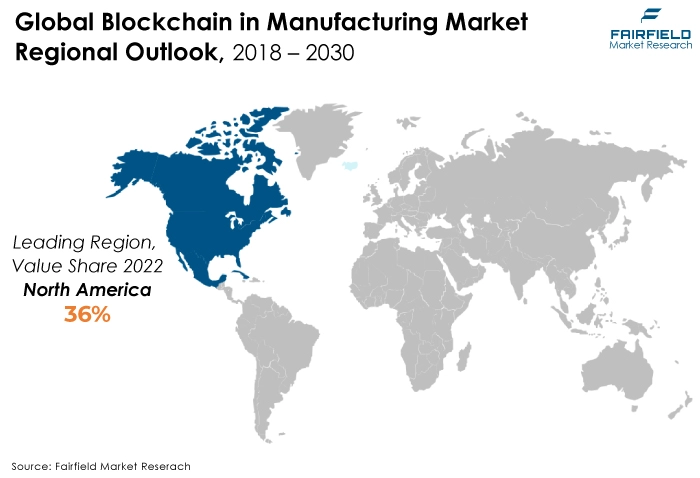
Asia Pacific
Asia Pacific is all set for the fastest pace of growth on the back of its rapidly expanding manufacturing sector, particularly in countries like China and India, is driving the adoption of blockchain to enhance supply chain efficiency, quality control, and traceability. Moreover, government initiatives to promote Industry 4.0 technologies and smart manufacturing are fuelling blockchain adoption.
Asia Pacific's strong presence in electronics, automotive, and pharmaceutical industries is driving the need for blockchain solutions to meet stringent regulatory requirements and ensure product authenticity. These factors collectively contribute to the rapid growth of blockchain in manufacturing in the region.
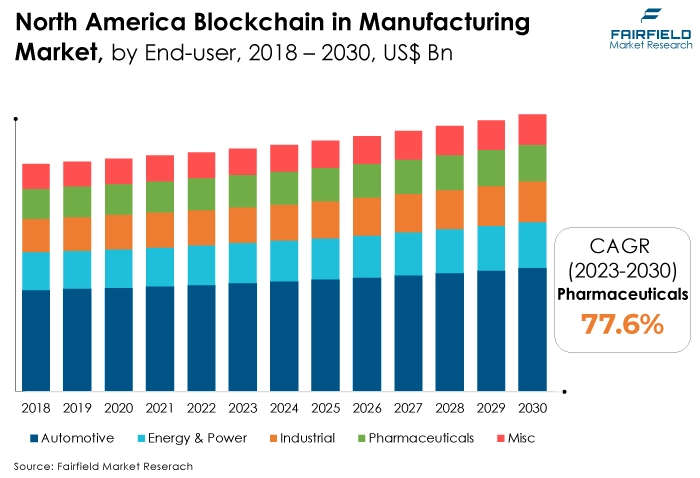
Fairfield’s Competitive Landscape Analysis
The global blockchain in the manufacturing market is consolidated, with fewer major players present globally. The key players are introducing new products and working on the distribution channels to enhance their worldwide presence. Moreover, Fairfield Market Research expects more consolidation over the coming years.
Who are the Leaders in the Global Blockchain in Manufacturing Space?
- IBM
- Microsoft
- Oracle
- SAP
- Amazon Webs Services
- Huawei
- Intel
- Wipro
- Blockchain App Factory
- R3
- Adept Minds
- Factom
- Chronicled
- SyncFab
- Skuchain
Key Company Developments
New Product Launch
- June 2022: Shell, Accenture, and American Express Global Business Travel joined forces to introduce Avelia, an innovative digital book-and-claim service designed for sustainable aviation fuel (SAF) within the realm of business travel. This pioneering program's initial phase aims to demonstrate the effectiveness of the book-and-claim concept, which ensures the verification of SAF's environmental attributes to corporate entities and airlines once the fuel has been integrated into the fuel network, all facilitated through blockchain technology.
Distribution Agreement
- April 2022: Intel Corporation has unveiled its latest innovation, the Intel Blockscale ASIC. This application-specific integrated circuit (ASIC) is tailored to deliver the necessary energy efficiency and computational power required for scalability and sustainability. Intel's utilisation of this silicon technology enables the production of substantial quantities without impacting the supply of new CPUs or GPUs. Consequently, the Intel Blockscale ASIC is poised to play a pivotal role in assisting Bitcoin mining enterprises in achieving their sustainability objectives and hash rate scaling targets in the foreseeable future.
An Expert’s Eye
Demand and Future Growth
The demand for blockchain in manufacturing is on the rise as manufacturers seek enhanced transparency, traceability, and operational efficiency. The technology's role in optimizing supply chains, ensuring product quality, and meeting regulatory requirements is driving adoption.
The future of this sector is poised to continue as more industries recognise the benefits of blockchain in streamlining processes, reducing costs, and improving compliance. As blockchain solutions evolve and become more accessible, the manufacturing sector is expected to witness increased integration and innovation in the coming years.
Supply Side of the Market
Leading countries in blockchain in manufacturing include the US, Germany, China, Japan, and South Korea. The US is a pioneer in blockchain adoption, with a strong focus on supply chain applications. Germany's manufacturing excellence drives blockchain innovation. China, and Japan are rapidly adopting blockchain in manufacturing to enhance efficiency and transparency. South Korea has a thriving tech ecosystem, fostering blockchain development.
These nations are at the forefront of integrating blockchain into manufacturing processes, fuelling the growth and innovation in this sector. The blockchain in manufacturing market primarily relies on digital infrastructure, including blockchain platforms, smart contracts, and IoT devices. These digital components are essential for creating transparent and secure manufacturing ecosystems.
There are no specific raw materials in the traditional sense but investments in high-performance computing equipment and cybersecurity measures are often required. Manufacturers of these digital components include major tech companies like IBM, Microsoft, and Oracle and specialised blockchain technology firms such as R3, Chain, and Hyperledger, who provide the foundational elements for implementing blockchain in manufacturing processes.
The Global Blockchain in Manufacturing Market is Segmented as Below:
By Application:
- Business Process Optimisation
- Logistics & Supply Chain Management
- Counterfeit Management
- Quality Control & Compliance
- Miscellaneous
By End-use Industry:
- Automotive
- Energy & Power
- Industrial
- Pharmaceuticals
- Miscellaneous
By Geographic Coverage:
- North America
- U.S.
- Canada
- Europe
- Germany
- U.K.
- France
- Italy
- Turkey
- Russia
- Rest of Europe
- Asia Pacific
- China
- Japan
- South Korea
- India
- Southeast Asia
- Rest of Asia Pacific
- Latin America
- Brazil
- Mexico
- Argentina
- Rest of Latin America
- Middle East & Africa
- GCC
- South Africa
- Egypt
- Nigeria
- Rest of the Middle East & Africa
1. Executive Summary
1.1. Global Blockchain in Manufacturing Market Snapshot
1.2. Future Projections
1.3. Key Market Trends
1.4. Regional Snapshot, by Value, 2022
1.5. Analyst Recommendations
2. Market Overview
2.1. Market Definitions and Segmentations
2.2. Market Dynamics
2.2.1. Drivers
2.2.2. Restraints
2.2.3. Market Opportunities
2.3. Value Chain Analysis
2.4. Porter’s Five Forces Analysis
2.5. COVID-19 Impact Analysis
2.5.1. Supply
2.5.2. Demand
2.6. Impact of Ukraine-Russia Conflict
2.7. Economic Overview
2.7.1. World Economic Projections
2.8. PESTLE Analysis
3. Global Blockchain in Manufacturing Market Outlook, 2018 - 2030
3.1. Global Blockchain in Manufacturing Market Outlook, by Application, Value (US$ Mn), 2018 - 2030
3.1.1. Key Highlights
3.1.1.1. Business Process Optimization
3.1.1.2. Logistics & Supply Chain Management
3.1.1.3. Counterfeit Management
3.1.1.4. Quality Control & Compliance
3.1.1.5. Misc.
3.2. Global Blockchain in Manufacturing Market Outlook, by End-use Industry, Value (US$ Mn), 2018 - 2030
3.2.1. Key Highlights
3.2.1.1. Automotive
3.2.1.2. Energy & Power
3.2.1.3. Industrial
3.2.1.4. Pharmaceuticals
3.2.1.5. Misc.
3.3. Global Blockchain in Manufacturing Market Outlook, by Region, Value (US$ Mn), 2018 - 2030
3.3.1. Key Highlights
3.3.1.1. North America
3.3.1.2. Europe
3.3.1.3. Asia Pacific
3.3.1.4. Latin America
3.3.1.5. Middle East & Africa
4. North America Blockchain in Manufacturing Market Outlook, 2018 - 2030
4.1. North America Blockchain in Manufacturing Market Outlook, by Application, Value (US$ Mn), 2018 - 2030
4.1.1. Key Highlights
4.1.1.1. Business Process Optimization
4.1.1.2. Logistics & Supply Chain Management
4.1.1.3. Counterfeit Management
4.1.1.4. Quality Control & Compliance
4.1.1.5. Misc.
4.2. North America Blockchain in Manufacturing Market Outlook, by End-use Industry, Value (US$ Mn), 2018 - 2030
4.2.1. Key Highlights
4.2.1.1. Automotive
4.2.1.2. Energy & Power
4.2.1.3. Industrial
4.2.1.4. Pharmaceuticals
4.2.1.5. Misc.
4.2.2. BPS Analysis/Market Attractiveness Analysis
4.3. North America Blockchain in Manufacturing Market Outlook, by Country, Value (US$ Mn), 2018 - 2030
4.3.1. Key Highlights
4.3.1.1. U.S. Blockchain in Manufacturing Market Application, Value (US$ Mn), 2018 - 2030
4.3.1.2. U.S. Blockchain in Manufacturing Market End-use Industry, Value (US$ Mn), 2018 - 2030
4.3.1.3. Canada Blockchain in Manufacturing Market Application, Value (US$ Mn), 2018 - 2030
4.3.1.4. Canada Blockchain in Manufacturing Market End-use Industry, Value (US$ Mn), 2018 - 2030
4.3.2. BPS Analysis/Market Attractiveness Analysis
5. Europe Blockchain in Manufacturing Market Outlook, 2018 - 2030
5.1. Europe Blockchain in Manufacturing Market Outlook, by Application, Value (US$ Mn), 2018 - 2030
5.1.1. Key Highlights
5.1.1.1. Business Process Optimization
5.1.1.2. Logistics & Supply Chain Management
5.1.1.3. Counterfeit Management
5.1.1.4. Quality Control & Compliance
5.1.1.5. Misc.
5.2. Europe Blockchain in Manufacturing Market Outlook, by End-use Industry, Value (US$ Mn), 2018 - 2030
5.2.1. Key Highlights
5.2.1.1. Automotive
5.2.1.2. Energy & Power
5.2.1.3. Industrial
5.2.1.4. Pharmaceuticals
5.2.1.5. Misc.
5.2.2. BPS Analysis/Market Attractiveness Analysis
5.3. Europe Blockchain in Manufacturing Market Outlook, by Country, Value (US$ Mn), 2018 - 2030
5.3.1. Key Highlights
5.3.1.1. Germany Blockchain in Manufacturing Market Application, Value (US$ Mn), 2018 - 2030
5.3.1.2. Germany Blockchain in Manufacturing Market End-use Industry, Value (US$ Mn), 2018 - 2030
5.3.1.3. U.K. Blockchain in Manufacturing Market Application, Value (US$ Mn), 2018 - 2030
5.3.1.4. U.K. Blockchain in Manufacturing Market End-use Industry, Value (US$ Mn), 2018 - 2030
5.3.1.5. France Blockchain in Manufacturing Market Application, Value (US$ Mn), 2018 - 2030
5.3.1.6. France Blockchain in Manufacturing Market End-use Industry, Value (US$ Mn), 2018 - 2030
5.3.1.7. Italy Blockchain in Manufacturing Market Application, Value (US$ Mn), 2018 - 2030
5.3.1.8. Italy Blockchain in Manufacturing Market End-use Industry, Value (US$ Mn), 2018 - 2030
5.3.1.9. Turkey Blockchain in Manufacturing Market Application, Value (US$ Mn), 2018 - 2030
5.3.1.10. Turkey Blockchain in Manufacturing Market End-use Industry, Value (US$ Mn), 2018 - 2030
5.3.1.11. Russia Blockchain in Manufacturing Market Application, Value (US$ Mn), 2018 - 2030
5.3.1.12. Russia Blockchain in Manufacturing Market End-use Industry, Value (US$ Mn), 2018 - 2030
5.3.1.13. Rest of Europe Blockchain in Manufacturing Market Application, Value (US$ Mn), 2018 - 2030
5.3.1.14. Rest of Europe Blockchain in Manufacturing Market End-use Industry, Value (US$ Mn), 2018 - 2030
5.3.2. BPS Analysis/Market Attractiveness Analysis
6. Asia Pacific Blockchain in Manufacturing Market Outlook, 2018 - 2030
6.1. Asia Pacific Blockchain in Manufacturing Market Outlook, by Application, Value (US$ Mn), 2018 - 2030
6.1.1. Key Highlights
6.1.1.1. Business Process Optimization
6.1.1.2. Logistics & Supply Chain Management
6.1.1.3. Counterfeit Management
6.1.1.4. Quality Control & Compliance
6.1.1.5. Misc.
6.2. Asia Pacific Blockchain in Manufacturing Market Outlook, by End-use Industry, Value (US$ Mn), 2018 - 2030
6.2.1. Key Highlights
6.2.1.1. Automotive
6.2.1.2. Energy & Power
6.2.1.3. Industrial
6.2.1.4. Pharmaceuticals
6.2.1.5. Misc.
6.2.2. BPS Analysis/Market Attractiveness Analysis
6.3. Asia Pacific Blockchain in Manufacturing Market Outlook, by Country, Value (US$ Mn), 2018 - 2030
6.3.1. Key Highlights
6.3.1.1. China Blockchain in Manufacturing Market Application, Value (US$ Mn), 2018 - 2030
6.3.1.2. China Blockchain in Manufacturing Market by End-use Industry, Value (US$ Mn), 2018 - 2030
6.3.1.3. Japan Blockchain in Manufacturing Market Application, Value (US$ Mn), 2018 - 2030
6.3.1.4. Japan Blockchain in Manufacturing Market End-use Industry, Value (US$ Mn), 2018 - 2030
6.3.1.5. South Korea Blockchain in Manufacturing Market Application, Value (US$ Mn), 2018 - 2030
6.3.1.6. South Korea Blockchain in Manufacturing Market End-use Industry, Value (US$ Mn), 2018 - 2030
6.3.1.7. India Blockchain in Manufacturing Market Application, Value (US$ Mn), 2018 - 2030
6.3.1.8. India Blockchain in Manufacturing Market End-use Industry, Value (US$ Mn), 2018 - 2030
6.3.1.9. Southeast Asia Blockchain in Manufacturing Market Application, Value (US$ Mn), 2018 - 2030
6.3.1.10. Southeast Asia Blockchain in Manufacturing Market End-use Industry, Value (US$ Mn), 2018 - 2030
6.3.1.11. Rest of Asia Pacific Blockchain in Manufacturing Market Application, Value (US$ Mn), 2018 - 2030
6.3.1.12. Rest of Asia Pacific Blockchain in Manufacturing Market End-use Industry, Value (US$ Mn), 2018 - 2030
6.3.2. BPS Analysis/Market Attractiveness Analysis
7. Latin America Blockchain in Manufacturing Market Outlook, 2018 - 2030
7.1. Latin America Blockchain in Manufacturing Market Outlook, by Application, Value (US$ Mn), 2018 - 2030
7.1.1. Key Highlights
7.1.1.1. Business Process Optimization
7.1.1.2. Logistics & Supply Chain Management
7.1.1.3. Counterfeit Management
7.1.1.4. Quality Control & Compliance
7.1.1.5. Misc.
7.2. Latin America Blockchain in Manufacturing Market Outlook, by End-use Industry, Value (US$ Mn), 2018 - 2030
7.2.1. Key Highlights
7.2.1.1. Automotive
7.2.1.2. Energy & Power
7.2.1.3. Industrial
7.2.1.4. Pharmaceuticals
7.2.1.5. Misc.
7.2.2. BPS Analysis/Market Attractiveness Analysis
7.3. Latin America Blockchain in Manufacturing Market Outlook, by Country, Value (US$ Mn), 2018 - 2030
7.3.1. Key Highlights
7.3.1.1. Brazil Blockchain in Manufacturing Market Application, Value (US$ Mn), 2018 - 2030
7.3.1.2. Brazil Blockchain in Manufacturing Market End-use Industry, Value (US$ Mn), 2018 - 2030
7.3.1.3. Mexico Blockchain in Manufacturing Market Application, Value (US$ Mn), 2018 - 2030
7.3.1.4. Mexico Blockchain in Manufacturing Market End-use Industry, Value (US$ Mn), 2018 - 2030
7.3.1.5. Argentina Blockchain in Manufacturing Market Application, Value (US$ Mn), 2018 - 2030
7.3.1.6. Argentina Blockchain in Manufacturing Market End-use Industry, Value (US$ Mn), 2018 - 2030
7.3.1.7. Rest of Latin America Blockchain in Manufacturing Market Application, Value (US$ Mn), 2018 - 2030
7.3.1.8. Rest of Latin America Blockchain in Manufacturing Market End-use Industry, Value (US$ Mn), 2018 - 2030
7.3.2. BPS Analysis/Market Attractiveness Analysis
8. Middle East & Africa Blockchain in Manufacturing Market Outlook, 2018 - 2030
8.1. Middle East & Africa Blockchain in Manufacturing Market Outlook, by Application, Value (US$ Mn), 2018 - 2030
8.1.1. Key Highlights
8.1.1.1. Business Process Optimization
8.1.1.2. Logistics & Supply Chain Management
8.1.1.3. Counterfeit Management
8.1.1.4. Quality Control & Compliance
8.1.1.5. Misc.
8.2. Middle East & Africa Blockchain in Manufacturing Market Outlook, by End-use Industry, Value (US$ Mn), 2018 - 2030
8.2.1. Key Highlights
8.2.1.1. Automotive
8.2.1.2. Energy & Power
8.2.1.3. Industrial
8.2.1.4. Pharmaceuticals
8.2.1.5. Misc.
8.2.2. BPS Analysis/Market Attractiveness Analysis
8.3. Middle East & Africa Blockchain in Manufacturing Market Outlook, by Country, Value (US$ Mn), 2018 - 2030
8.3.1. Key Highlights
8.3.1.1. GCC Blockchain in Manufacturing Market Application, Value (US$ Mn), 2018 - 2030
8.3.1.2. GCC Blockchain in Manufacturing Market End-use Industry, Value (US$ Mn), 2018 - 2030
8.3.1.3. South Africa Blockchain in Manufacturing Market Application, Value (US$ Mn), 2018 - 2030
8.3.1.4. South Africa Blockchain in Manufacturing Market End-use Industry, Value (US$ Mn), 2018 - 2030
8.3.1.5. Egypt Blockchain in Manufacturing Market Application, Value (US$ Mn), 2018 - 2030
8.3.1.6. Egypt Blockchain in Manufacturing Market End-use Industry, Value (US$ Mn), 2018 - 2030
8.3.1.7. Nigeria Blockchain in Manufacturing Market Application, Value (US$ Mn), 2018 - 2030
8.3.1.8. Nigeria Blockchain in Manufacturing Market End-use Industry, Value (US$ Mn), 2018 - 2030
8.3.1.9. Rest of Middle East & Africa Blockchain in Manufacturing Market Application, Value (US$ Mn), 2018 - 2030
8.3.1.10. Rest of Middle East & Africa Blockchain in Manufacturing Market End-use Industry, Value (US$ Mn), 2018 - 2030
8.3.2. BPS Analysis/Market Attractiveness Analysis
9. Competitive Landscape
9.1. Manufacturer vs Application Heatmap
9.2. Company Market Share Analysis, 2022
9.3. Competitive Dashboard
9.4. Company Profiles
9.4.1. IBM
9.4.1.1. Company Overview
9.4.1.2. Product Portfolio
9.4.1.3. Financial Overview
9.4.1.4. Business Strategies and Development
9.4.2. Microsoft
9.4.2.1. Company Overview
9.4.2.2. Product Portfolio
9.4.2.3. Financial Overview
9.4.2.4. Business Strategies and Development
9.4.3. Oracle
9.4.3.1. Company Overview
9.4.3.2. Product Portfolio
9.4.3.3. Financial Overview
9.4.3.4. Business Strategies and Development
9.4.4. SAP
9.4.4.1. Company Overview
9.4.4.2. Product Portfolio
9.4.4.3. Financial Overview
9.4.4.4. Business Strategies and Development
9.4.5. Amazon Web Services
9.4.5.1. Company Overview
9.4.5.2. Product Portfolio
9.4.5.3. Financial Overview
9.4.5.4. Business Strategies and Development
9.4.6. Huawei
9.4.6.1. Company Overview
9.4.6.2. Product Portfolio
9.4.6.3. Financial Overview
9.4.6.4. Business Strategies and Development
9.4.7. Intel
9.4.7.1. Company Overview
9.4.7.2. Product Portfolio
9.4.7.3. Financial Overview
9.4.7.4. Business Strategies and Development
9.4.8. Wipro
9.4.8.1. Company Overview
9.4.8.2. Product Portfolio
9.4.8.3. Financial Overview
9.4.8.4. Business Strategies and Development
9.4.9. Blockchain App Factory
9.4.9.1. Company Overview
9.4.9.2. Product Portfolio
9.4.9.3. Financial Overview
9.4.9.4. Business Strategies and Development
9.4.10. R3
9.4.10.1. Company Overview
9.4.10.2. Product Portfolio
9.4.10.3. Financial Overview
9.4.10.4. Business Strategies and Development
9.4.11. Adept Minds
9.4.11.1. Company Overview
9.4.11.2. Product Portfolio
9.4.11.3. Financial Overview
9.4.11.4. Business Strategies and Development
9.4.12. Factom
9.4.12.1. Company Overview
9.4.12.2. Product Portfolio
9.4.12.3. Financial Overview
9.4.12.4. Business Strategies and Development
9.4.13. Chronicled
9.4.13.1. Company Overview
9.4.13.2. Product Portfolio
9.4.13.3. Financial Overview
9.4.13.4. Business Strategies and Development
9.4.14. SyncFab
9.4.14.1. Company Overview
9.4.14.2. Product Portfolio
9.4.14.3. Financial Overview
9.4.14.4. Business Strategies and Development
9.4.15. Skuchain
9.4.15.1. Company Overview
9.4.15.2. Product Portfolio
9.4.15.3. Financial Overview
9.4.15.4. Business Strategies and Development
10. Appendix
10.1. Research Methodology
10.2. Report Assumptions
10.3. Acronyms and Abbreviations
|
BASE YEAR |
HISTORICAL DATA |
FORECAST PERIOD |
UNITS |
|||
|
2022 |
|
2018 - 2022 |
2023 - 2030 |
Value: US$ Million |
||
|
REPORT FEATURES |
DETAILS |
|
Application Coverage |
|
|
End-use Industry Coverage |
|
|
Geographical Coverage |
|
|
Leading Companies |
|
|
Report Highlights |
Key Market Indicators, Macro-micro economic impact analysis, Technological Roadmap, Key Trends, Driver, Restraints, and Future Opportunities & Revenue Pockets, Porter’s 5 Forces Analysis, Historical Trend (2019-2021), Market Estimates and Forecast, Market Dynamics, Industry Trends, Competition Landscape, Category, Region, Country-wise Trends & Analysis, COVID-19 Impact Analysis (Demand and Supply Chain) |
